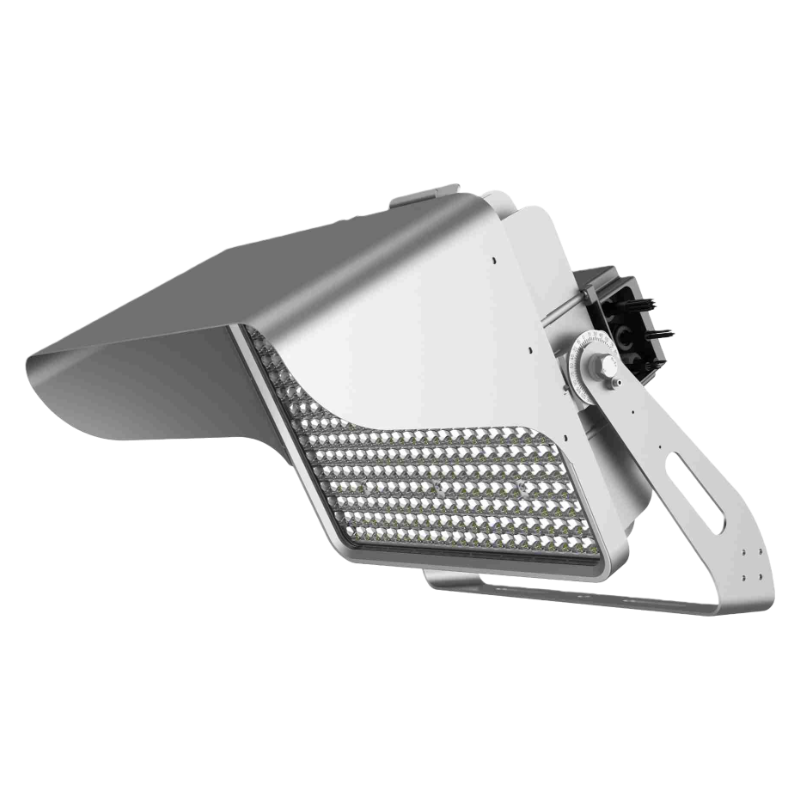#Arena Lighting Solutions ·
#LED Sports Lights Guide ·
#LED Stadium Lights ·
#Sports Venue Lighting ·
#Stadium LED Lighting ·
The Complete Guide to LED Sports Lights for Stadiums and Arenas
Introduction: The Critical Role of Lighting in Stadiums & Arenas
Stadiums and arenas are dynamic spaces where every detail impacts the fan experience, player performance, and broadcast quality—and lighting is no exception. For years, traditional lighting like metal halide struggled to keep up with the demands of modern sports: slow warm-up times disrupted games, uneven light caused visibility issues, and high energy costs strained budgets. Today, LED sports lights have emerged as the gold standard, offering unparalleled control, efficiency, and reliability. But with the variety of options available, navigating the world of LED sports lighting can be daunting. This complete guide covers everything you need to know—from what LED sports lights are and their key specifications to how to select, install, and maintain them—ensuring your stadium or arena gets the perfect lighting solution for every game, event, and broadcast.
What Are LED Sports Lights, and What Makes Them Unique?
LED sports lights are high-performance lighting fixtures specifically engineered for the rigorous demands of sports venues, from local baseball fields to professional NFL stadiums. Unlike generic LED high bays, they’re designed to prioritize broadcast compatibility, uniform illumination, and extreme durability. Here’s what sets them apart:
-
High-Intensity Output:Professional arenas require 200,000-1,500,000+ total lumens, and LED sports lights deliver 50,000-300,000 lumens per fixture—far exceeding standard LED fixtures.
-
Precision Optics:Advanced lens and reflector systems create narrow beam angles (10°-60°) that target light directly onto playing surfaces, minimizing glare for players and reducing light pollution in surrounding areas.
-
Broadcast-Grade Quality:Compliant with international standards (FIFA Class 4, UEFA Category A, MLB Standard) with CRI ≥ 90 and CCT 5000K-6500K, ensuring accurate color representation for TV cameras and in-person viewing.
-
Weather & Vibration Resistance:IP65+ ratings protect against rain, dust, and extreme temperatures (-40°F to 130°F), while rugged aluminum housings withstand crowd vibrations and stadium acoustics. Outdoor stadiums in rainy climates may need IP67 for full waterproofing, while indoor arenas benefit from IP65 to resist dust from crowd foot traffic.
Key Specifications to Consider When Choosing LED Sports Lights
Selecting the right LED sports lights starts with understanding critical specs tailored to stadium and arena needs:
-
Luminance & Uniformity:Luminance (measured in lux) varies by sport and venue tier. Professional soccer stadiums hosting international matches need 1,000-2,000 lux, while amateur fields require 300-500 lux. Uniformity is non-negotiable—aim for 90%+ uniformity, meaning the brightest and darkest spots on the playing surface differ by no more than 10%. Poor uniformity creates blind spots for players (e.g., a soccer player misjudging a pass due to a dark patch) and inconsistent visuals for broadcasters, leading to washed-out footage.
-
Color Rendering Index (CRI):CRI rates how accurately light displays colors compared to natural daylight. For sports, a CRI of ≥90 is mandatory. This ensures jersey colors (e.g., a team’s red vs. maroon) are distinct, ball details (like a baseball’s stitching) are clear, and player features are recognizable—critical for both in-person spectators and TV viewers. A low CRI (below 80) can blur color distinctions, hampering game strategy and fan engagement.
-
Color Temperature (CCT):Measured in Kelvin (K), CCT determines light warmth. Stadiums and arenas thrive with 5000K-6500K (cool white) light. This range mimics natural daylight, reducing eye strain for players during 90-minute soccer matches or 4-hour baseball games. It also ensures consistent color reproduction across TV cameras—warm white (3000K-4000K) appears too soft, making the playing surface look dim and washed out on screen.
-
Beam Angle:Beam angle controls light spread. Narrow angles (10°-30°) work for tall stadiums (40ft+ ceilings), focusing light downward onto the field without wasting it on stands or the sky. Wider angles (30°-60°) suit mid-height arenas (20-40ft ceilings) like basketball or hockey rinks, ensuring even coverage across smaller playing surfaces. Multi-sport venues benefit from adjustable beam angle fixtures to switch between sports (e.g., soccer to concerts) seamlessly.
-
Glare Rating (UGR):Unified Glare Rating (UGR) measures light harshness. For sports, UGR ≤19 is essential to prevent eye discomfort. LED sports lights use anti-glare optics and diffusers to soften light, so players can track fast-moving objects (e.g., a hockey puck or tennis ball) without squinting. Glare also disrupts broadcasts—too much glare causes camera washed-outs during critical plays.
-
Smart Control Compatibility:Modern venues need flexible lighting. Look for fixtures with DMX512 or IoT integration. DMX enables dynamic effects: pre-game light shows synced to team anthems, color shifts for halftime performances, or dimming for post-game ceremonies. IoT controls let you monitor energy use remotely, schedule brightness adjustments (e.g., dim for practice, max for games), and even troubleshoot issues without physical inspections.
Selecting the right LED sports lights starts with understanding critical specs tailored to stadium and arena needs:
-
Luminance & Uniformity:Luminance (measured in lux) varies by sport and venue tier. Professional soccer stadiums hosting international matches need 1,000-2,000 lux, while amateur fields require 300-500 lux. Uniformity is non-negotiable—aim for 90%+ uniformity, meaning the brightest and darkest spots on the playing surface differ by no more than 10%. Poor uniformity creates blind spots for players (e.g., a soccer player misjudging a pass due to a dark patch) and inconsistent visuals for broadcasters, leading to washed-out footage.
-
Color Rendering Index (CRI):CRI rates how accurately light displays colors compared to natural daylight. For sports, a CRI of ≥90 is mandatory. This ensures jersey colors (e.g., a team’s red vs. maroon) are distinct, ball details (like a baseball’s stitching) are clear, and player features are recognizable—critical for both in-person spectators and TV viewers. A low CRI (below 80) can blur color distinctions, hampering game strategy and fan engagement.
-
Color Temperature (CCT):Measured in Kelvin (K), CCT determines light warmth. Stadiums and arenas thrive with 5000K-6500K (cool white) light. This range mimics natural daylight, reducing eye strain for players during 90-minute soccer matches or 4-hour baseball games. It also ensures consistent color reproduction across TV cameras—warm white (3000K-4000K) appears too soft, making the playing surface look dim and washed out on screen.
-
Beam Angle:Beam angle controls light spread. Narrow angles (10°-30°) work for tall stadiums (40ft+ ceilings), focusing light downward onto the field without wasting it on stands or the sky. Wider angles (30°-60°) suit mid-height arenas (20-40ft ceilings) like basketball or hockey rinks, ensuring even coverage across smaller playing surfaces. Multi-sport venues benefit from adjustable beam angle fixtures to switch between sports (e.g., soccer to concerts) seamlessly.
-
Glare Rating (UGR):Unified Glare Rating (UGR) measures light harshness. For sports, UGR ≤19 is essential to prevent eye discomfort. LED sports lights use anti-glare optics and diffusers to soften light, so players can track fast-moving objects (e.g., a hockey puck or tennis ball) without squinting. Glare also disrupts broadcasts—too much glare causes camera washed-outs during critical plays.
-
Smart Control Compatibility:Modern venues need flexible lighting. Look for fixtures with DMX512 or IoT integration. DMX enables dynamic effects: pre-game light shows synced to team anthems, color shifts for halftime performances, or dimming for post-game ceremonies. IoT controls let you monitor energy use remotely, schedule brightness adjustments (e.g., dim for practice, max for games), and even troubleshoot issues without physical inspections.
-
Luminance & Uniformity:Luminance (measured in lux) varies by sport and venue tier. Professional soccer stadiums hosting international matches need 1,000-2,000 lux, while amateur fields require 300-500 lux. Uniformity is non-negotiable—aim for 90%+ uniformity, meaning the brightest and darkest spots on the playing surface differ by no more than 10%. Poor uniformity creates blind spots for players (e.g., a soccer player misjudging a pass due to a dark patch) and inconsistent visuals for broadcasters, leading to washed-out footage.
-
Color Rendering Index (CRI):CRI rates how accurately light displays colors compared to natural daylight. For sports, a CRI of ≥90 is mandatory. This ensures jersey colors (e.g., a team’s red vs. maroon) are distinct, ball details (like a baseball’s stitching) are clear, and player features are recognizable—critical for both in-person spectators and TV viewers. A low CRI (below 80) can blur color distinctions, hampering game strategy and fan engagement.
-
Color Temperature (CCT):Measured in Kelvin (K), CCT determines light warmth. Stadiums and arenas thrive with 5000K-6500K (cool white) light. This range mimics natural daylight, reducing eye strain for players during 90-minute soccer matches or 4-hour baseball games. It also ensures consistent color reproduction across TV cameras—warm white (3000K-4000K) appears too soft, making the playing surface look dim and washed out on screen.
-
Beam Angle:Beam angle controls light spread. Narrow angles (10°-30°) work for tall stadiums (40ft+ ceilings), focusing light downward onto the field without wasting it on stands or the sky. Wider angles (30°-60°) suit mid-height arenas (20-40ft ceilings) like basketball or hockey rinks, ensuring even coverage across smaller playing surfaces. Multi-sport venues benefit from adjustable beam angle fixtures to switch between sports (e.g., soccer to concerts) seamlessly.
-
Glare Rating (UGR):Unified Glare Rating (UGR) measures light harshness. For sports, UGR ≤19 is essential to prevent eye discomfort. LED sports lights use anti-glare optics and diffusers to soften light, so players can track fast-moving objects (e.g., a hockey puck or tennis ball) without squinting. Glare also disrupts broadcasts—too much glare causes camera washed-outs during critical plays.
-
Smart Control Compatibility:Modern venues need flexible lighting. Look for fixtures with DMX512 or IoT integration. DMX enables dynamic effects: pre-game light shows synced to team anthems, color shifts for halftime performances, or dimming for post-game ceremonies. IoT controls let you monitor energy use remotely, schedule brightness adjustments (e.g., dim for practice, max for games), and even troubleshoot issues without physical inspections.











